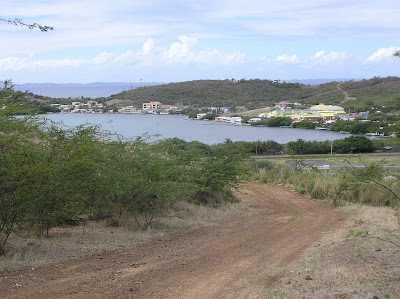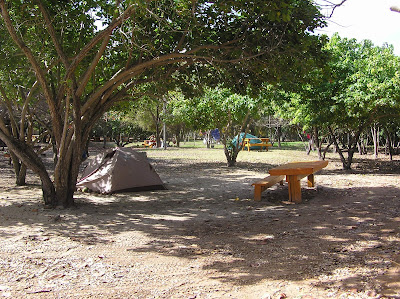The Culebra Forum at IslaCulebra.com is a peerless resource for anyone who'd like to visit Culebra. You can search the archives for your topic of choice, or post a new inquiry for residents and frequent visitors to answer. I'd spent a lot of time reading these forums, trying to decide what I needed to bring and what I didn't. There were many requests for information on Culebra's climate and I read through all the replies, how it was really very warm at night, how even cold sleepers had found a flannel sheet was more than enough.
I am a cold sleeper. I always doubt other people's advice on what to bring for sleeping. This time, though, I relaxed my guard a little. If other cold sleepers didn't need much, well. I just brought my fleece blanket.
I was cold.
I spent much of my first night tossing and turning, trying to get the blanket to cover both my wool-sock-shrouded feet and hood-cocooned head, trying to get warm. I was wearing all the layers I could manage and stayed above shivering temperature, but wasn't exactly comfortable. It could have been worse, though. The noodle bed was certainly supportive, if a bit firm.

Noodle bed, "pillow" made from clothing in duffel bag, black fleece blanket on top, hammock and some other items. Don't laugh.
It was cloudy so I decided to explore the island a bit. I thought it was important to find the nicest places early in my vacation so that I'd know where I wanted to spend my time. It wouldn't be any good if I spent the week at the beach I was camping on only to find on the last day that there was one I liked better down the coast, would it?
With my tourist map, the most accurate-looking representation of the land I'd been able to find, I set out to travel from Flamenco Beach, where I was camping, to Resaca Beach. I walked south up the steep road from the coast, looking for the jeep trail the map indicated led northeast to Resaca. After a bit of back and forth I still hadn't found it, so walked down toward the airport to try to find the real road that led toward the beach. I walked past a hill that reminded me just how dry the island is.

It took about half an hour to get to the airport. It was beginning to get hot. I started wandering around the nearby roads, trying to figure out whether I was on the right one. I found myself on another jeep trail that wandered behind the airport, came out onto a brief stretch of newly paved road in the middle of nowhere with benchless picnic tables under cupolas overgrown with grass that looked like they'd been built in a fit of optimism five years ago and then forgotten about, and which soon turned into a jeep trail again.

The sun came out. I walked past houses with TV blaring, houses with men working on cars out front, barky little dogs, lots of chickens, tourists in rented jeeps. I hit on what I thought was the right road and started climbing up to the spine of the island. It was steep as heck. I took a picture of a similarly steep road across the bay.

Walking up to the end of the street was like climbing six flights of stairs. I hadn't put on any sunscreen and even as the sun came out I nixed it for my legs, reasoning that I'd be vertical and there'd never be much direct light on them. I looped around jeep trails, trying to find my way up over the mountain.

Ensenada bay (perhaps the safest from hurricanes in all the Caribbean), with the town of Dewey. In the distance is the island of Vieques.
I passed an old trailer that was disintegrating in the elements, and was struck by the contrast between it and the newer buildings along the bay.


I realized I wasn't getting over the mountain, came down and found the actual right road, which went up and up and up. It turned from an asphalt, house-lined climb to a white concrete road winding through trees with only an occasional vacation house visible through the branches. I walked over a little bridge, peering down into the ravine on one side, and just caught sight of a big iguana before it dashed into the grass. The first time I'd seen one in the wild! And the road kept climbing. I'd been walking for three hours now, on a quest that was meant to take only about an hour. After all, Resaca Beach is just along the coast from Flamenco. Now I was sweating under the hot sun, far away from any beach.
I heard a noise and turned around.

It was the first horse I'd seen on Culebra. There are tons of horse on Vieques, of a special breed called the paso fino. This horse naturally has a very rapid, smooth gait with almost no bouncing up and down and they're sort of oddly fascinating to watch (see this amazing video on YouTube). I interacted with this horse for a bit, forgetting the ache in my shoulders, until I heard another noise behind me.

How cute! The foal was less interested in me than the mother was. I watched them for a bit longer.

Then it was back to the climb. Not long before noon I reached the top of the road. There was a sign for the Culebra National Wildlife Refuge, telling me I was approaching a sea turtle nesting beach. My tourist map said the beach was a half-hour hike down the side of the mountain. A half an hour? Surely not! It covered an itty-bitty distance on the map! I was happy to get into the full shade and began clambering down over basalt boulders through the forest. It wasn't long before I noticed there were lizards everywhere. Tiny brown and grey lizards. I got a picture of one that was little wider than the blade of grass it was resting on:
 If your browser allows, click on the image for detail. I assume it is a Puerto Rican anole.
If your browser allows, click on the image for detail. I assume it is a Puerto Rican anole.The trail passed down into a spooky mangrove forest, branches and roots everywhere.
 These mounds, which I saw many of on the trees, were a mystery to me. This one was maybe a foot and a half high. Its surface looked like lichen.
These mounds, which I saw many of on the trees, were a mystery to me. This one was maybe a foot and a half high. Its surface looked like lichen.At last, after exactly half an hour, I broke out onto the beach. The waves were absolutely pounding the coast in a strong wind, and sea spray made the whole scene look fuzzy, out of focus.
 The wind was coming in from the northeast and the waves were breaking chaotically, in all directions, up to five feet high or so. I couldn't imagine anyone wanting to swim here. The sand was more orangey than the picture shows. I took a long walk up the beach in the roar and spray, seeing human footprints but no other signs of people. I did see these tracks:
The wind was coming in from the northeast and the waves were breaking chaotically, in all directions, up to five feet high or so. I couldn't imagine anyone wanting to swim here. The sand was more orangey than the picture shows. I took a long walk up the beach in the roar and spray, seeing human footprints but no other signs of people. I did see these tracks: Undoubtably from an iguana, with the tail drag mark. I also found this on the other side of the beach:
Undoubtably from an iguana, with the tail drag mark. I also found this on the other side of the beach:
A sea turtle nest! You can see the tracks made by the sea turtle and a hollow where I presumed the eggs were buried. I was also able to do a little beachcombing here as there were a number of very small shells, including a real treasure... baby nautilus shells.
The nautilus is different from other mollusks. Take a look at this picture of a nautius shell sliced in half. Unlike a snail shell, which is all open on the inside, a nautlius shell has chambers that are closed off except for a small tube in the wall of each. A nautilus can control its bouyancy by inserting part of its body into the different chambers and pumping as many as it likes full of gas. Thus it cruises the ocean, catching food with its tentacles, much more like a squid than it is like a snail, though all are related. At any rate, nautilus shells are unmistakable. My little specimens, less than an inch in diameter, had the chambers and tubes just like the big ones you can find for sale as home decorating items.
Before I left I visited the far distant end of the beach, looking again for that elusive jeep trail the map said was supposed to exist, to find nothing but a mysterious cabana erected by some vanished visitor:

I slipped back into the forest and began my hike back to the road. I did see another kind of lizard, a Puerto Rican ameiva. These were much bigger, though they wouldn't let me get close.
 Perhaps the oddest thing I saw, though, was this:
Perhaps the oddest thing I saw, though, was this: These bugs are called cotton stainers, because their bodies can get crushed into the cotton they feed on. I would guess they're mating, though possibly they're playing rugby.
These bugs are called cotton stainers, because their bodies can get crushed into the cotton they feed on. I would guess they're mating, though possibly they're playing rugby.Tune in later for the rest of my adventures!




